The Spring Frolic and Winnipesaukee the Hard Way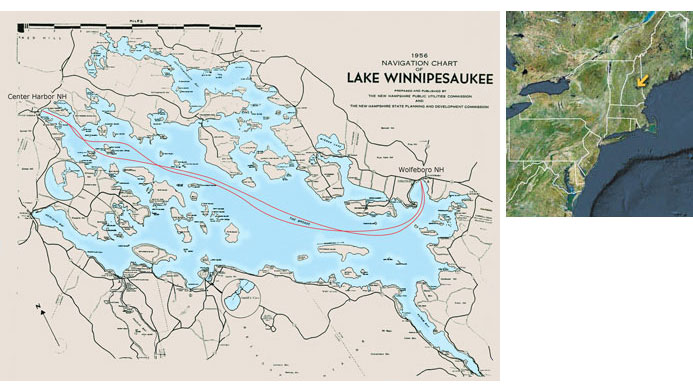
In the Northeast of the U.S., there is a spring iceboat party that sometimes materializes at Lake Winnepesaukee in New Hampshire. It's known as the Spring Frolic. Even more occasionally there is a New England Ice Yacht Association event called "Winnepesaukee the Hard Way," which is a cruising event from Wolfeboro to Center Harbor and back. Thanks to Bob Kilpatrick and Jeff Brown for these articles on the subject, Bob Kilpatrick, Jeff Soderholm, Jack Erikson, and Leo Healy for the photos. --ed
1, A Little History, by Bob Kilpatrick
2, Hard Way, March 13, 2004, by Jeff Brown
A Little History, Revised and Corrected, of the New England Ice Yacht
Association’s “Winnipesaukee The HardWay” Award
By Bob Kilpatrick
The first reported iceboat transit from Wolfeboro to Center
Harbor and return (in modern memory) was accomplished in 1947
by Leigh Turner’s father, Norman Turner, and Furber Jewett.
According to Leigh, both sailed Mead skeeters that they had
purchased in the late 1930s. Since there had been iceboats on
Winnipesaukee for 50 years or so before that, it is likely that others
preceded them. Leigh reports
that he and Erik Erikson made
their first unofficial lap of the
lake in 1971, sailing DNs.
Including the first NEIYA
officially-recognized
circumnavigation Lake
Winnipesaukee in 1974, there
have been fifteen “official”
iceboat fleets certified to have
accomplished the feat. That first
official “HardWay” fleet
consisted of seven boats, sailed by
Hal Chamberlain, Don “Doc”
Fellows, Stew Hamel, Leo Healy,
Paul Healy, Dick Price, and Leigh
Turner.
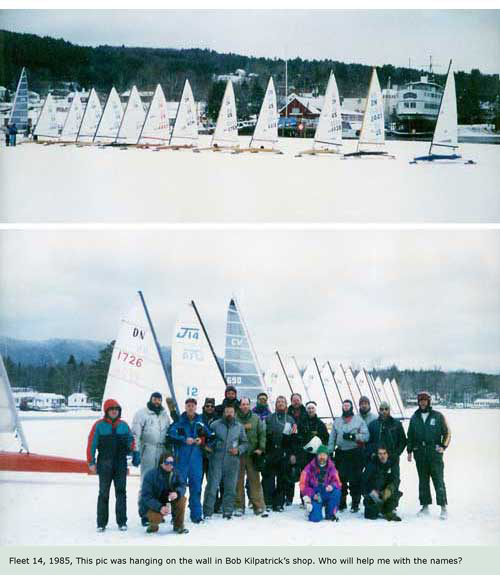 Bill Converse and Bill Fisher
made a non-qualifying expedition
in 1979. In 1985, six years later, a
fleet of twenty-three boats in Fleet
#2 made a successful loop of the
lake. It was in 1985 that formal
conditions for a “HardWay”
award were implemented. Bill Converse and Bill Fisher
made a non-qualifying expedition
in 1979. In 1985, six years later, a
fleet of twenty-three boats in Fleet
#2 made a successful loop of the
lake. It was in 1985 that formal
conditions for a “HardWay”
award were implemented.
With the exception of Fleet #3
on February 11, 1991, all
successful attempts have been
done between the 9th and the 20th days in the month of March.
The last successful circumnavigation was on March 13, 2004. As of
that date, 108 skippers have qualified for the coveted “HardWay”
award, most in DNs. The most trips for one skipper is six,
accomplished, appropriately, by HardWay Review Committee
Chairman Leo Healy. Leo has made the loop four times in his
Northeast Class skeeter, and also twice in a DN. Chasing Leo’s record
total, Dave Burnham and Paul Zucco are the only skippers to have
done five qualifying trips. Dave and Paul have done all five of their
trips in DNs.
Dick Price and Jon Hix are the only four-trippers on the roster.
Dick Price has three trips in NE28 and one in his DN. Jon Hix had
the distinction of doing it in three different classes of iceboat, first a
stern-steerer, then a DN, and the last two in his J-14. Jon’s sternsteerer, “Phantom,” is the only one of its type to have made the
course.
Six others have three official loops under their belts: Hal
Chamberlain, Stew Hamel, Leigh Turner, Bob Kilpatrick, Jeff Brown,
and Steve Wright. Jeff has two loops standing on an ice board and one
in the solid comfort of a DN. One of Leigh’s trips was in the
big skeeter “Thin Ice,” in 1991.
Sixteen skippers have made two
trips, and eighty-two others have
made one official loop.
One South Bay Scooter,
skippered by Dave Farrell, with
plenty of “moveable ballast” has
been officially recorded and,
speaking of traveling standing
up, two other iceboard sailors (in
addition to Jeff Brown) have
done it, Alex Wadson and Chad
Lyons. Lloyd Roberts has made
two loops in the “Mother of All
Gambits,” G-1.
No history of the “HardWay”
would be complete without
mention of the “Thunder Run”
from Center Harbor to Brewster
Beach made by Jeff Kent and
Peter Hill during the 1995
Spring Frolic. No onlooker who
saw the two of them hit the
beach after a screaming
overpowered record-setting run
from Center Harbor doubted
that something noteworthy had just occurred.
No “HardWay” has been completed since 2004, when twenty
boats in Fleet 15 made it. For your attempt, all you need to do is
round up at least five boats, at least one skipper who has received a
previous HardWay award, and at least one (dues paid) NEIYA
member in good standing, pack up safety gear, spares, and tools, and
go for it.
NEIYA membership is not required for each individual
participant, but it is certainly encouraged. Don’t forget to make a
detailed report upon completion of your circuit.
Remember: Assistance and shelter is a long way from the middle of
Halfway to Center Harbor,
Lake Winnipesaukee. Brewster Beach,Wolfeboro to Center Harbor is
twenty-seven miles each way. To accomplish the whole trip you may
end up sailing over a hundred miles. Sharp runners, and be prepared.
There are good reasons why pilots do their own pre-flight
inspections.
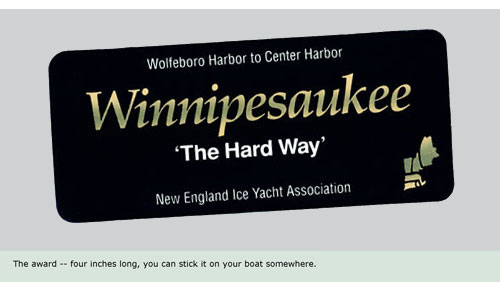
Bob Kilpatrick’s Notes from Experience on the Hardway:
1, In most cases two small fleets are better than one large one. It is
easier to keep track of your fellow sailors and reef crossings go faster.
Remember though, if you do split a large fleet into two or more,
Official NEIYA Qualifying Conditions apply to each fleet, to include
at least one NEIYA member in good standing (dues paid) in each
fleet.
2, Use the wind as best you can when you have it. You never know
how long it will last, and it can be a long push back to your launch point.
3, Eat breakfast someplace where they have lake chart placemats.
Also, if you have a real chart, it might fit rolled up inside your boom. It’s easy to get disoriented out there.
4, Toss or slide big ice chunks out onto the clear ice from your reef
crossing points to make it easier to find the spot again on the way
back from Center Harbor. This may not be necessary now that we
have GPS waypoints, but remember that the ice moves fast; do not assume that the crossing is still safe without checking it.
5, At reef crossings, a couple of lead boats scout for a crossing point
and stop. If the crossing is sailable, wave boats through between you,
otherwise help carry them over. Even if reef crossings appear to be
sailable, raise your tiller so you don’t take it in the teeth in the event of
a sudden stop.
6, One designated Lead boat and one designated “Trail” boat. The
Lead boat concentrates on navigation and clear ice. The Trail boat
concentrates on counting sails and making sure the fleet stays intact
and in front of him. The fleet in turn needs to keep an eye on the Trail boat. Everybody counts sails at reef crossings.
7, If you have a choice, the style of steering runner with the brake
on the front of the blade is best on this trip. If you lose the wind, it’s a
great place to tie your mainsheet so you can pull the boat rather than
push it. Again, it can be a long push back.
8, Each fleet should have at least one set of spare dry clothing. On
a gray Winnipesaukee day, open “leads” can look just like ice. Some of
us carry “space blanket” survival sacks; they come folded to the size of
a pack of cigarettes.
9, The roll of duct tape goes without saying. Smart iceboaters put a
couple of spare clevis pins in their empty adjuster holes, especially on
big ice.When the rig comes down, a departed pin is usually the
culprit. No big thing if you have a spare right there. “For lack of a nail…”
10, Long experience has shown that, if the wind is strong and
steady from the north, a prudent skipper would consider taking along a storm sail, especially for the possible wild ride from Center Harbor
to Wolfeboro. --Bob Kilpatrick TOP

Hard Way, March 13, 2004
by Jeff Brown
The word spreads quickly to a network of alert sailors ready to move on a moments notice. The prior weekend of March 6th, several sailors hit the freshly cleaned surface of Lake Winnipesaukee and the conditions were explored for a possible Hard Way attempt.
The Winnipesaukee Frolic was called on for March 13 & 14, by one of Wolfboro's finest local ice sailors and scouts, Allen Stevens. This was indeed big business for the epic ice sailing weekend which lay ahead. Sailors would descend from miles and miles to meet up for the last great event of the year, swapping stories of the season and showing off their toys.
But the traditional and elusive "Hard Way" odyssey, which often is the chatter during many of our adventures, looked like a real possibility for the upcoming weekend. Last accomplished in 1995 and only 14 successful trips dating back to 1974, this journey is indeed one of New England's finest ice sailing aspirations, personal achievement and group bonding efforts.
Friday, sailors arrived and set boats up at the Brewster Beach launch in Wolfboro Bay. The wind was already blowing 15-20 NW as the current storm system passed and the forecast was for 20-30 NW on Saturday, plenty of power to pull off a Hard Way, but maybe too much wind?
The weekend was also planned for the DN Eastern Championships, which has been tormented by postponements for two years and several attempts. To add to the excitement, the A Skeeters were in town just to show off their extreme machines and tear up the large lake.
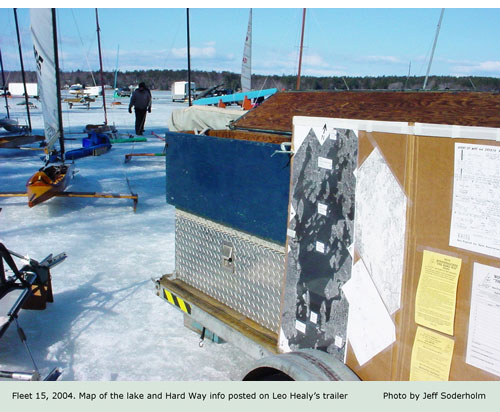 On Saturday morning it was obvious that all racing was out of the question as the wind blew 25-35 and howled through the stays of at least 100 boats waiting for the wind to subside. Those who gathered early for the Hard Way rigged and waited and waited ....for someone to make a call. At first we thought the wind would back off by 9 am, then 10 am, but at 10:30 it was as strong as ever and some decided to simply try and sail. Others were going to stay put. On Saturday morning it was obvious that all racing was out of the question as the wind blew 25-35 and howled through the stays of at least 100 boats waiting for the wind to subside. Those who gathered early for the Hard Way rigged and waited and waited ....for someone to make a call. At first we thought the wind would back off by 9 am, then 10 am, but at 10:30 it was as strong as ever and some decided to simply try and sail. Others were going to stay put.
Leo Healy, our Hard Way veteran of the first trips in history, was sailing out to the full exposure in the lake for "the litmus test". He came back in and coasted around the pits and inner harbour. He stopped, some one asked "are you organizing the Hard Way", he replied, "no..no, the Hard Way organizes itself".
That is when I got it. "Organize them and they will come", I said to myself. I consulted Leo about taking a few hard core sailors equipped with storm sails to make an attempt. I explained my thoughts, that due to the NNW direction of wind that it would be OK to sail upwind and sail home nearly dead downwind. If the wind switched to the west along the way we would return home and bail the attempt. A west wind would have made for a deadly speed reach which was far beyond our safety requirements for a Hard Way adventure.
I called for those interested to gather the boats in front of the parked Frolic fleet. The DN racers quickly shifted from race mode to survival mode and swapped for storm sails....if you had 'em. We gathered what looked to be about 10 sailors, checked their rigging and explained the event they were about to commit to. No sailor would return home without a partner. No sailor would remain alone if they had equipment failure. They all new the risks and we were ready to move out.
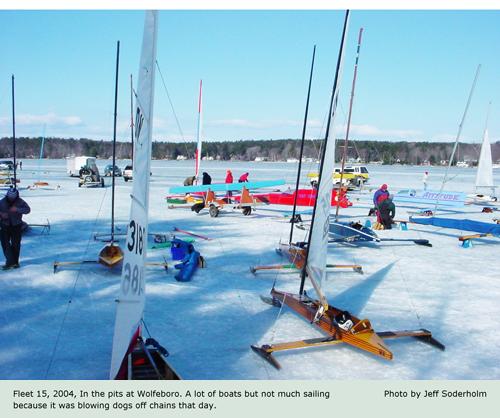 At 11:15 we left the launch to head for the first boat count at Parker's Island, just a mile or two out the bay. As we left, I hear someone hoot "and there they go.... they're off!" We had left many behind who wished the wind was easier going, but after all this was the "Hard Way". At 11:15 we left the launch to head for the first boat count at Parker's Island, just a mile or two out the bay. As we left, I hear someone hoot "and there they go.... they're off!" We had left many behind who wished the wind was easier going, but after all this was the "Hard Way".
Some years we need to cross many pressure ridges which makes it hard, this year it would be the severe wind for the challenge and the ice was indeed a bit rough, but the word was there were no ridges to cross, so far as we knew of. We still needed to watch out. We pulled up to Parker's in the full exposure gauntlet of 25-35 mph winds. You had to hold onto your boat even with the parking brake on!
I began counting sails, 17 total! A few racers were carrying full sails!
I see the red skeeter guy coming up who said he would make the trip, then his sail failed and the boom was on the ice, he was out and so we set out for the trip with our standing head count. I planned to stop several times, the first stop the middle of the Broads.
We worked hard to windward keeping the boats on the ice, hiking was dangerous. After 20 minutes we stop in the Broads with the wind still ripping violently. The lake is nearly 7 miles wide at this point.
I count 17 again and we are off to Six mile Island for the next count. We pass a fishing shack with several onlookers taking our photos.
We leave the Broads and begin heading up the narrows and we are now nearly half way to our Center Harbour destination. This is where only the veterans know where to go. The shoreline from where we came is now gone to the distant distortion of endless ice. The way ahead is unclear and full of "false summits" as the islands block the views from bay to bay. At six mile island I see 3 more sailors following our lead and they eventually join up.
Onward to 3 mile island for the next leg and next count. Someone says we have come nearly 18 miles according to GPS. We push to windward with many tacks as the narrows neck down to only 2 miles wide. Now I see it, Center Harbour ahead, but not before about 20 more tacks. I get to the shore, park the boat and touch down firmly on the beach like nailing a summit victory. Time: 12:30 sharp.
What a scene to see the fleet arrive one by one and more on the way. I pull each sailor ashore by hand to congratulate their achievement and soon we were all standing, grinning in a group on the sandy beach. It was like a summer day out of the wind in the gleaming sunshine!
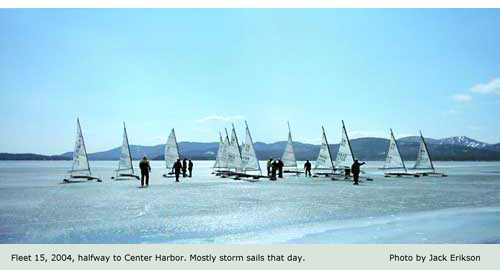
Now for the damage reports. We got Doug Sharp in his Gambit with a frayed stay, Steve Wright's DN with a splintered plank. His wife followed up in her car, unknowingly, she happens to arrive with a spare! What a deal! Ed Atkeson has a slightly bent aluminum mast and lost his front runner bolt right at the finish. He crossed the street to the True Value hardware store and bought another. Doug's stay gets lashed with Jack Erikson's spare rescue line.
After lunch we take the traditional group picture in front of the DN fleet with the Mt. Washington lake ferry in the background. Then we're off for the return trip and we knew it would be a radical event. I tail sweep the fleet out the harbour as I see others peeling off on speed runs. Three miles out I see a boat flip and the sailor get catapulted on the ice. I sail over and see that it is Steve Wright. "are you OK?" He's fine, a bit shook up, so we right his boat and he is off.
Three miles later I am screaming full tilt in a slight hike, then suddenly I jump an 8" plate depression, land skidding and then the full pitchpole on to the ice with the boat on top of me. I grab onto the stay to keep with the boat, eventually everything stops. Am I hurt? I see blood on my face, but its just a little scrape. My rear took the brunt of it and the shredded britches prove it. My leg took a slight impact as well. I thank my lucky stars for fairing the fall and vow to keep the return trip home "under the speed limit". I climb back into the boat and off to the waiting fleet parked nearby at six mile island. I explained my delay and concern about the fleet spreading too far and for others to watch more closely.
Next stop the fishing shack in the upper broads. We gather there for another head count and prepare for the open big ice speed run. Just wind it up, off you go for miles and miles! What about my planned Rattlesnake Island Stop? Others kept cruising and eventually we all stop at Parker's Island for the "off the plate" count. Everything is in order we go home now. Not far from there, Paul Zucco's mast comes down. Jack Erikson and I stop to assist. He lost the pin, but worst, he then ran over the stay and frayed it nearly through. We set it up with a new pin and follow him slowly limping into the launch.
We made it with no one seriously hurt, lost or broken boats, It was indeed a successful voyage. Time completed 2:45 pm.
My GPS records 46.6 miles round trip. Then I was off to get the details with everyone's names, addresses and explanations of "experiences" to get the papers in order.
Statistical highlights -- Gear damage report:
• Greg Cornelius frayed his storm sail through at the tack.
• Doug Sharp frayed his side stay on the upwind leg. Repaired at Center Harbour with new rope.
• Ed Atkeson bent his aluminum mast during the first ten minutes with a full sail. Then lost runner pin at Center Harbour.
• Dave Fortier lost head batten on upwind leg. Made a new batten from a sapling in a nearby wooded island! He was running a full sail.
• Steve Wright splintered a plank going up wind and had it replaced by his roadside assisting wife with a spare.
• Jeff Brown breaks tiller brace during wipeout pitch poll.
• Eric Anderson bent his bobstay going downwind through the broads over some "roughage"
• Paul Zucco lost stay pin, then ran over and frayed stay nearly through.
Radical sailing maneuvers / wipe outs:
• James "T" Thieler flips on upwind leg, carrying full sail. "It was nothing!"
• Harry Richardson has "capsize-spinout-recovery" as he manages to keep with the boat, capsized, spinning, then the wind re-righting everything with him back into the cockpit and ...sailed away. He had a full sail on too.
• Steve Wright flips off wind with a spectacular body flying catapult.
• Jeff Brown with a first ever pitchpole, "but I'm not going to let the boat go this time" hang on, britcher tearing wipeout.
Other notable achievements:
• Jack Erikson is recognized for most assists and best prepared.
• Brain Langley hits 63.2 mph on GPS in the broads to make the fastest sailor of the day.
Unofficial 2004 Hard Way completion, Fleet #15
(subjected to "Hard Way" review board)
First timer roundups:
Carl Broadbent - US 93
Brian Langley - US 5178
Doug Wright - US 3792
Doug Sharp - Gambit
Greg Cornelius - US 1019
Steve Madden - US 4512
Ernie Dessaules - US 4919
Robert Strzelewicz (Bob S.) - US 4850
Dave Fortier - US 4690
Harry Richardson - US 5148
James "T" Thieler - US 5224
Eric Anderson - US 5193
Jack Erikson - US 3186
Ed Atkeson - US 5105
Veteran roundups:
Bill Converse - US 2804 - 2 timer (unofficial 5 timer)
Jeff Brown - US 5232 - 3 timer (2nd fleet leader)
Steve Wright - US 289 - 3 timer
Dave Burnham - US 3987 - 5 timer
Paul Zucco - US 3791 - 5 timer
Leo Healy - US 1925 - 6 timer (Fleet 1, Hard Way 1974)
At home I explain to my wife about the trip and how we completed the event. Of course I show her my minor bruised leg while exiting the shower. "Its not so bad", I explain. "Oh ya", she says, "you should see the one on your rump roast!" She was right, it's like an eggplant!
Jeff Brown
US 5232
TOP
|
|
|
